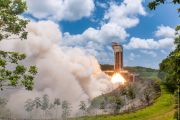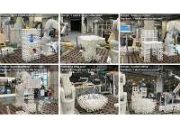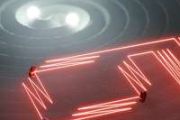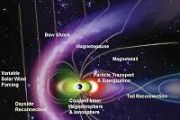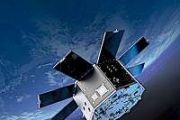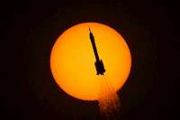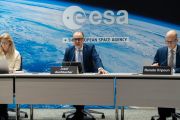
Copernical Team
China to complete lunar outpost by 2028
 China will possibly complete the establishment of a lunar research outpost based on two robotic exploration missions by 2028 and send Chinese astronauts to the moon around 2030, according to the chief designer of China's lunar exploration program.
Wu Weiren, also an academician of the Chinese Academy of Engineering and the director of the country's deep-space exploration laboratory, said r
China will possibly complete the establishment of a lunar research outpost based on two robotic exploration missions by 2028 and send Chinese astronauts to the moon around 2030, according to the chief designer of China's lunar exploration program.
Wu Weiren, also an academician of the Chinese Academy of Engineering and the director of the country's deep-space exploration laboratory, said r Cutting-edge experiments ride SpaceX's 26th CRS mission to space station
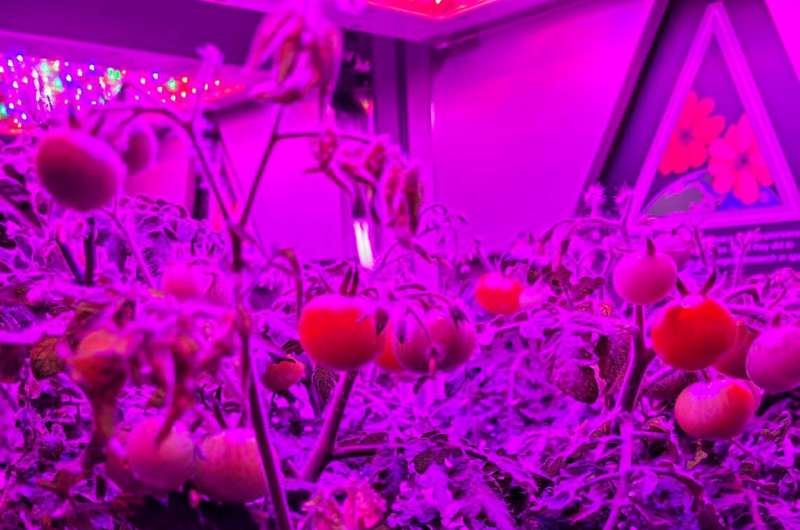
SpaceX's 26th commercial resupply mission (CRS) is scheduled to launch to the International Space Station from NASA's Kennedy Space Center in Florida in late November. The Dragon spacecraft carries scientific experiments and technology demonstrations that explore growing plants in space, creating nutrients on-demand, in-space construction, and more.
Here are details on some of the research launching to the space station:
Big hopes for small tomatoes
A continuous source of nutritious food is essential for long-duration exploration missions, and the typical pre-packaged astronaut diet may need to be supplemented by fresh foods produced in space. Researchers have been testing a plant growth unit on station known as Veggie and have successfully grown a variety of leafy greens.
D-Orbit signs payload hosting contract with SpacePNT
 The space transportation and logistics company D-Orbit has announced the signing of a hosted payload contract with SpacePNT, a Swiss company specialized in the design and manufacturing of low cost high-accuracy GNSS receivers for the New Space satellite market.
The contract covers the integration of a new GNSS receiver prototype into ION Satellite Carrier, D-Orbit's proprietary orbital tra
The space transportation and logistics company D-Orbit has announced the signing of a hosted payload contract with SpacePNT, a Swiss company specialized in the design and manufacturing of low cost high-accuracy GNSS receivers for the New Space satellite market.
The contract covers the integration of a new GNSS receiver prototype into ION Satellite Carrier, D-Orbit's proprietary orbital tra The new astronauts selected by the European Space Agency
 The European Space Agency named five new career astronauts Wednesday, as well as the world's first recruit with a disability and 11 other reserve astronauts who will have to wait for their chance to go to space.
- Sophie Adenot -
The 40-year-old French engineer has flown 3,000 flight hours as a helicopter test pilot.
Her masters at MIT in the United States included work on how to des
The European Space Agency named five new career astronauts Wednesday, as well as the world's first recruit with a disability and 11 other reserve astronauts who will have to wait for their chance to go to space.
- Sophie Adenot -
The 40-year-old French engineer has flown 3,000 flight hours as a helicopter test pilot.
Her masters at MIT in the United States included work on how to des Astronomers observe intra-group light - the elusive glow between distant galaxies
 An international team of astronomers have turned a new technique onto a group of galaxies and the faint light between them - known as 'intra-group light' - to characterise the stars that dwell there.
Lead author of the study published in MNRAS, Dr Cristina Martinez-Lombilla from the School of Physics at UNSW Science, said "We know almost nothing about intra-group light.
"The brightes
An international team of astronomers have turned a new technique onto a group of galaxies and the faint light between them - known as 'intra-group light' - to characterise the stars that dwell there.
Lead author of the study published in MNRAS, Dr Cristina Martinez-Lombilla from the School of Physics at UNSW Science, said "We know almost nothing about intra-group light.
"The brightes Many planets could have atmospheres rich in helium, study finds
 For centuries, no one knew if we were alone in the universe-or if there were even other planets like ours.
But thanks to new telescopes and methods in the past decades, we now know there are thousands and thousands of planets out there circling faraway stars, and they come in all sorts of shapes and sizes-large and small, rocky and gaseous, cloudy or icy or wet.
A study by scientists
For centuries, no one knew if we were alone in the universe-or if there were even other planets like ours.
But thanks to new telescopes and methods in the past decades, we now know there are thousands and thousands of planets out there circling faraway stars, and they come in all sorts of shapes and sizes-large and small, rocky and gaseous, cloudy or icy or wet.
A study by scientists Orion Exits the Lunar Sphere Of Influence
 On the eighth day of its mission, Orion continues to travel farther away from the Moon as it prepares to enter a distant retrograde orbit. The orbit is "distant" in the sense that it's at a high altitude from the surface of the Moon, and it's "retrograde" because Orion will travel around the Moon opposite the direction the Moon travels around Earth.
Orion exited the gravitational sphere of
On the eighth day of its mission, Orion continues to travel farther away from the Moon as it prepares to enter a distant retrograde orbit. The orbit is "distant" in the sense that it's at a high altitude from the surface of the Moon, and it's "retrograde" because Orion will travel around the Moon opposite the direction the Moon travels around Earth.
Orion exited the gravitational sphere of New research reveals space debris, invisible meteors and near-Earth asteroids
 In a new thesis from the Swedish Institute of Space Physics and Umea University, unique methods for the analysis of radar data and simulations of meteoroids in the solar system are presented. The methods have been applied to confirm the existence of rare high-altitude meteors as well as to measure space debris from the Kosmos-1408 satellite. On November 25, Daniel Kastinen defends his doctoral t
In a new thesis from the Swedish Institute of Space Physics and Umea University, unique methods for the analysis of radar data and simulations of meteoroids in the solar system are presented. The methods have been applied to confirm the existence of rare high-altitude meteors as well as to measure space debris from the Kosmos-1408 satellite. On November 25, Daniel Kastinen defends his doctoral t A picture is worth a thousand words
 From the image Perseverance recently took at Yori Pass, we can see that there are gray rocks scattered on top of a tan colored rock surface below. What do these different colors tell us? As planetary geologists, our job is to figure out through physical and chemical observations the story that these rocks tell us about Yori Pass and its place within the delta in Jezero Crater. Color is one of th
From the image Perseverance recently took at Yori Pass, we can see that there are gray rocks scattered on top of a tan colored rock surface below. What do these different colors tell us? As planetary geologists, our job is to figure out through physical and chemical observations the story that these rocks tell us about Yori Pass and its place within the delta in Jezero Crater. Color is one of th European Service Module powering Orion to the Moon and back
 The European Service Module is powering Orion around the Moon and back, providing propulsion, temperature control, electricity as well as storage and delivery for essential supplies such as fuel, water and air. This first Artemis mission is an uncrewed test mission, putting the spacecraft through its paces preparing to send astronauts forward to the Moon.
After liftoff at 07:47 CET (06:47
The European Service Module is powering Orion around the Moon and back, providing propulsion, temperature control, electricity as well as storage and delivery for essential supplies such as fuel, water and air. This first Artemis mission is an uncrewed test mission, putting the spacecraft through its paces preparing to send astronauts forward to the Moon.
After liftoff at 07:47 CET (06:47 














